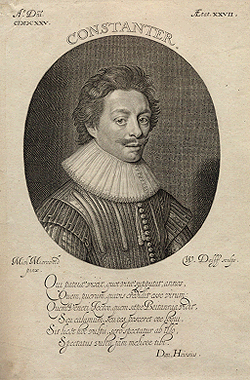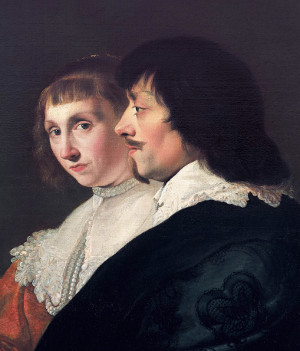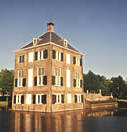One of the most complex and fascinating personalities of the Dutch seventeenth century was Constantijn Huygens (1596–1687) (fig. 1, 2 & 3), father of the famous physicist Christiaan Huygens Jr. (1629–1695). Huygens may be considered the Northern Baroque incarnation of the ideal Renaissance courtier described in Baldassare Castiglione's treatise Il Cortigiano. He was broadly educated in languages, law, and social protocol to follow an important public career. From his first years, his parents had encouraged him to explore the arts as well: he later became one of the Netherlands' most important art connoisseurs. He served in this last capacity as artistic advisor to Frederik Hendrik, the Prince of Orange (1584–1647). This was probably Huygens' motive for seeking out Rembrandt (1606–1669) and Jan Lievens (1607–1674) in their shared studio in Leiden, in 1628.

Lord of Zuylichem
(born in The Hague, 4 September, 1596; died in The Hague, 28 March, 1687)
Huygens wrote verse in five languages, as well as in Dutch. His poems, descriptive and satirical, were highly esteemed. His verse is graceful, highly ornamented, and sometimes moralistic.
From the year 1625, Huygens was secretary to the stadtholder, or the chief executive of the province of The Hague, and a valuable diplomat as well. Other statesmen surpassed him in political influence, and at least two other poets surpassed him in the value and originality of their writings, but his figure was more dignified, his talents more varied and his overall accomplishments more remarkable than those of any other person of his age, the greatest age of Dutch history.
Huygens had a significant influence upon the cultural development of the Netherlands. Among his many accomplishments, he brought the young Rembrandt to the attention of the elite court of The Hague and introduced the Delft scientist Anthonie van Leeuwenhoek (1632–1723) to the Royal Society in London.
Huygens is also of particular interest to Vermeer scholarship. Although there exists no direct testimony, circumstantial evidence points to the fact that Huygens must have known Vermeer's painting and was responsible for the visit of two art connoisseurs to his studio in Delft; Baron Balthasar de Monconys (a French diplomat) in August 1663, and Pieter Teding van Berckhout in May 1669. It may also be that Huygens brokered the sale of one of Vermeer's musical theme paintings to his fellow musical friend Diego Duarte from Antwerp. If Huygens's supposed ties with Vermeer were indeed true, this would place the Delft painting master squarely within the uppermost artistic milieu of the time.

Susanna van Baerle (detail)
Jacob van Campen
c. 1635
Oil on canvas, 95 x 78.5 cm.
Mauritshuis, The Hague

and Philips and the daughter Susanna)
Adriaen Hanneman
1640,
Oli on canvas, 204.2 x 173.9 cm.
Mauritshuis, The Hague
Huygens's personal interest and competence in music cannot be underestimated. Therefore, a closer look at the important role music played in his life will be helpful not only for a better understanding of his complex personality but to explore the problematic Dutch musical scene and the influence he had upon it.
The Musical Life of Constantijn Huygens
Constantijn Huygens was the second son of Christiaan Huygens, secretary of the Council of State of the Dutch Republic, and Susanna Hoefnagel, niece of the Antwerp painter Joris Hoefnagel.
Huygens grew up in The Hague and received a thorough humanistic education in languages, sciences, and the arts, as well as in dancing, fencing, and horseback-riding. His father, who gave him his first singing lessons, took great care of his son's musical education both for aesthetic pleasure it might yield but for the purpose of improving his social skills as well. In the coming years, music would provide Constantijn invaluable assistance in his profession as the personal secretary to the Stadtholder, Prince Frederick Henry of Orange (1625–1647) and to the latter's son and successor, William II (1647–1650). He was always grateful to his parents for his education. In Huygens' words: "Thanks to them that a little child of five, I was fed sweet sounds along with my first spoonfuls."
At the age of five, Huygens learned to play the cittern (a popular metal-stringed instrument), followed by the viol and lute. His viola da gamba teacher was an Englishman called "William H." (perhaps the English military man William Heydon), and his lute teacher was Jeronimus van Someren, a local musician, who later taught Huygens' sons Christiaan and Constantijn. Huygens was taught to play the virginal (fig. 4) and organ by the blind organist of The Hague's Grote Kerk, Pieter de Vois. Afterward, he learned to play theorbo and the guitar.
Huygens' youthful travels familiarized him with the musical modes and practices of the southern Netherlands, England (various visits, 1618–1624, from 1621 as secretary of diplomatic missions) and Venice (1620, as secretary of a diplomatic mission, where he had the opportunity to listen to the finest Italian musicians, including Monteverdi). In 1621, on his second visit to England, Huygens was knighted by King James VI, as he had greatly pleased the king with his viol playing during his first visit in 1618, even though the king was not particularly fond of music.
In 1627 he married Susanna van Baerle, daughter of a rich Amsterdam merchant. Together, they had five children. After the death of Susanna in 1637, Huygens celebrated the pleasures and virtues of their married life in a remarkable didactic poem called Daghwerck,which was not published until many years afterwards. Until his death, Huygens was a member of the Council of the Domains of the House of Orange. This position provided him with a permanent connection to the Orange Nassau family. Later diplomatic missions took him to Brussels (1656, 1657), Paris (1661–65) and London (1663, 1664, 1670–71).

Johannes Ruckers (attributed to)
1640
Poplar, spruce, oak, bone, paper, metal, leather, l 150 x 48.0 x 22 cm.
Rijksmuseum
The virginal, like the harpsichord, is a keyboard instrument the strings of which are plucked by plectra. Used mostly in domestic contexts, virginals were smaller and usually less costly than harpsichords. These instruments were often played by young girls, giving rise to the name ‘virginal’. The decoration of this instrument is not painted, but consists of printed paper.
Huygens' surviving correspondence, poems, diaries, journals and memoirs, furnish us with detailed insights into his musical activities. For example, he strictly separated his negotium (employment) from his otium (leisure time, devoted to the arts, especially poetry and music). Although he considered music first and foremost as a pastime, he was also keenly aware that it was a means of self-promotion in both personal and professional circles. Music had played a significant role in securing contact with several musical amateurs in the upper-class society of the northern and the southern Netherlands, for example with the Haarlem priest J.A. Ban, or with the Duarte family of wealthy Antwerp jewelers. The Duarte family was known to have possessed particularly refined musical talents, as we will see from a closer look at this family.
Huygens considered Paris to be the center of the musical universe. In his correspondence with the French theologian and music theorist Marin Mersenne and the French philosopher René Descartes (1596–1650), he touched upon matters of music frequently. His contact with professional musicians included Antoine Boësset, Nicholas Lanier, Jacques Gautier, Jacques Champion de Chambonnières, Thomas Gobert, Giovanni Paolo Foscarini, Luigi Rossi, or the German Johann Jakob Froberger. Sometimes Huygens used them as intermediaries to acquire musical instruments or manuscripts. Gaspard Duarte supported Huygens with technical advice for the purchase of a costly virginal made by Johannes Couchet (nephew of the famous Johannes Ruckers of Antwerp) in 1648.Edwijn Buijsen, "Music in the Age of Vermeer," in Dutch Society in the Age of Vermeer, ed. M. C. van der Sman (Zwolle: Waanders Publications, 1996), 116–118. One such instrument appeared in Vermeer's Music Lesson.
Expert opinion:
Was Huygens in Contact with Vermeer?
by Ben BroosBen Broos, "Un celebre peijntre nommé Verme[e]r," in: Johannes Vermeer in exh. cat. Johannes Vermeer. Arthur K. Wheelock Jr. and Ben Broos, London and New Haven: Yale University Press, 1995, 49.
One gains the strong impression that it was thanks to his [Balthasar de Monconys's] contacts in The Hague that the French diplomat had been able to take note of the most famous Dutch artists of that era, such as Van Mieris and Dou in Leiden, and Johannes Vermeer in Delft.
Constantijn Huygens must therefore have performed a minor but vital role in the theater of Vermeer's life. Huygens was, of course, one of the greatest authorities of his age where art was concerned. He maintained lively contacts with the Flemish painters Rubens, and Van Dyck, and his visit to the shared workshop of Jan Lievens and Rembrandt in Leiden is legendary. Why should Huygens himself have had no contact with Vermeer, when he urged others to visit the artist's studio? One document gives reason to believe that he did, in fact, visit the artist. Pieter Teding van Berckhout (1643–1713), a member of the Hague's regents' class, whose sister eventually married Constantijn's son Lodewijk, kept a diary. In it he recounted that he went to visit the famous painter Vermeer in Delft on 14 May, 1669. He had arrived there that day by towing barge and presumably disembarked at the Rotterdam or Schiedam Gate "where were Monsieurs de Zuylichem [Huygens], van der Horst and Nieuwport." That is, he joined the company of Constantijn Huygens and his friends, member of parliament Ewout van der Horst, and ambassador Willem Nieupoort. ... Although it does not say explicitly that all four men visited Vermeer, we may assume that Huygens and his friends did not linger at the city gate.
Air de cour and two Dutch songs
Constantijn Huygens (1596–1687)
Performed by: Jasper Schweppe (bass-baritone), Harry van Berne (tenor) and Willem Mook (lute)
The present air de cour and the Dutch songs are not part of the Pathodia. The Dutch songs were composed on the tune of popular songs, while the air de cour has probably been composed by Huygens himself.
Huygens had turned abroad to satisfy his musical appetite because he was deeply disappointed by the bleak musical situation in his own country. As a composer, he once referred to himself as "the one-eyed man who is king in the land of blind." The Calvinist practice of unaccompanied congregational singing in religious services was a musical horror for him. In 1641 he published anonymously the short treatise, Gebruyck of ongebruyck van 't orgel in de kercken der Verenighde Nederlanden ("Whether or not to use the organ in the churches of the United Netherlands") in which he put forward the case for reintroducing the organ as an accompaniment to the congregational singing. The treatise aroused positive responses from scholars and literary figures alike, but at the same time incited fierce opposition from the clergy. Jan Janszoon Calckman responded in his pamphlet Antidotum, tegen-gift vant Gebruyck of on-gebruyck vant orgel in de kercken der Vereenighde Nederlanden (The Hague, 1641).
In all, Huygens composed more than 800 pieces of music throughout his life, mainly consisting of solo pieces for the five instruments he possessed. Unfortunately, almost every one of them is lost. Only one allemande for viola da gamba has survived.Tim Crawford, "Allemande Mr. Zuilekom. Constantijn Huygens Sole Surviving Instrumental Composition," Tijdschrift van de Vereniging voor Nederlandse Muziekgeschiedenis XXXVII (1987): 175–181.
Que ferons-nous
Constantijn Huygens (1596–1687)
Performed by: La Sphera Armoniosa
Psalmus VI
Constantijn Huygens (1596–1687)
Performed by: Emma Brown (mezzo-soprano) and Robert Sinha (lutenist)
His only published work (under the pseudonym Occupatus—"a very busy man") is the Pathodia sacra et profana (fig. 5), published 1647 by the famous Parisian editor Robert Ballard. It contains pieces for voice and continuo in an expressive, personal style, combining elements of Latin psalms, Italian madrigals and French chansons. Huygens dedicated the work to one of his best musical friends, Utricia Ogle (born in Utrecht—hence her unusual first name). She was a talented singer and lute player and Huygens had frequently accompanyied her performances on the theorbo. In 1658, Huygens wrote about the Kerck-gebruyck der psalmen ("The use of the psalms in the church," i.e. in the service).
Pathodia sacra et profana,
under the pseudonym "Occupatus,"
edited 1647 by Robert Ballard, Paris.
Since Huygens performed and enjoyed music exclusively within a circle of close friends, belonging to the cultural elite of refined musical taste, his compositions in the Italian Baroque style were fairly inaccessible to the general public and thus could be appreciated only by a select few: Nullement viande pour tout palais ("not flesh for every palate")Louis Peter Grijp, "Dutch Music of the Golden Age," in The Hoogsteder Exhibition of Music & Painting in the Golden Age, eds. Edwin Buijsen and Louis Peter Grijp (The Hague; Zwolle: Waanders Publishers, 1994), 74.—as he wrote.
We will meet Huygens again at the Duarte family as well as in the Muiderkring (Muiden-Circle).

Expert opinion
"Allemande Mr. Zuilekom": Constantijn Huygens' Sole Surviving Instrumental CompositionCrawford, Tim. "Allemande Mr. Zuilekom". Constantijn Huygens’s Sole Surviving Instrumental Composition." Tijdschrift van de Vereniging Voor Nederlandse Muziekgeschiedenis 37 (1987): 175–181..
by Tim Crawford
When, near the end of his long and hugely productive life, Constantijn Huygens wrote of the "effroyable liste" of his over 800 instrumental works, part of his mind must have been on posterity. We know that he kept his compositions in large volumes where they were carefully numbered. Sadly, although the Huygens Nachlass [estate] includes a vast quantity of poetry, prose and letters in the writer's autograph, today, there is no trace of these music manuscript books. Huygens was proud of his musical accomplishments—justifiably so, judging by the quality of the vocal music in Pathodia (1647)—and he would have been aware that his literary output, much of which was of a semi-official nature, stood a better chance of preservation than his music. It is ironic that, despite the precaution of leaving the music autographs to his son Christiaan (presumably since he was the one of his children most likely to preserve or make use of them), the instrumental works today present the most prominent lacuna in the Huygens heritage.
Happily, a single instrumental work has now turned up in an unexpectedly remote source, the family library of count Leopold von Goëss at Schloss Ebenthal, near Klagenfurt in the Austrian province of Carinthia. The principal musical treasure of this important library, only uncovered by the American scholar, Douglas Alton Smith, in 1979, is a remarkable series of no fewer than 13 manuscript volumes of music in French tablature for lute, theorbo, and viola da gamba from the seventeenth and eighteenth centuries.
A letter written from Rembrandt van Rijn to Constantijn Huygens concerning the sale of paintings.
Honored Lord,I have complete trust that everything will go well and in particular regarding my compensation for these last 2 pieces trusting your lordship that if it had gone according to of your lordship's favor and what is right there would have been no objection to the agreed price. And as far as the pieces delivered earlier no more than 600 carolus guilders were paid for each. And if his Highness can not be moved to a higher price with good will although they are admittedly worth it, I can be satisfied with 600 c. guilders each, as long as my outlay for the 2 ebony frames and the crate, which is 44 guilders, can be included in the account. So I would kindly request of my lord that I may now soon receive my payment here in Amsterdam, trusting that due to the good favor shown me I will soon enjoy my monies, while I remain grateful for all such friendship. And with my heartfelt greetings to my lord and to all your lordship's nearest friends, all are commended to God in long-lasting health.
Your Lordship's r. and affectionate servant
Rembrandt
Huygens on the web:
- The Hofwijck Story
- Constantijn Huygens: Poetry
- Religious Poems of Constantijn Huygens (1596–1687) dbnl Digitaale bibliotheek voor de Nederlandsen letteren: [most extensive overview over the works]
- Religious Poems of Constantijn Huygens (1596–1687) (English translations © Peter J. Large, 1996)
- Portrait of Constantijn Huygens at the Rijksmuseum
- Constantijn Huygens engraved glass
Anna Roemers Visscher - herself a poet - engraved this glass as a gift for the famous poet Constantijn Huygens: 'AEN Constantinus Huygens' is the inscription in beautiful calligraphy. It is one of the finest pieces in the glass collection. - https://www.uco.es/ucopress/ojs/index.php/mediterranea/article/view/6713/6304
Suggested listening:
Allemande for viola da gamba
- Muziek Uit De Gouden Eeuw
Music from the Golden Age: A musical double-portrait of Constantijn Huygens (1596–1687) and Gerbrandt Adriaensz Bredero (1585–1618), performed by Camerata Trajectina, 1992
Huygensmuseum Hofwijck Website
http://www.hofwijck.nl/en/

"Two Gates speak of more: be I greeting friend or guest. "t is not by one door yet by two open doors;
the spacious entrance shows what is to happen And that friends are welcome to my bread and my wine,
not half, not whole, not once, but twice."
(Hofwijck poem, lines 1064–1068)